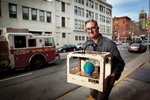1. Wilfried Vancraen, Materialise

Will there ever be a 3D Printer in every home?
To be honest, no, I don’t think there will be or should be a 3D printer in every home. In the hands of some, these home 3D printers will be powerful tools and they will create great things. However, if they are abused, they will add to the environmental damage already being done with meaningless mass production by adding even more useless objects to the pile of waste our society already produces. That being said, I think there is a potential for kitchens to start including food 3D printers. We consume food on a daily basis, so if we use the printer even once a week we can not only bring a little variety and fun into our meals but it will also be worth owning such a machine. And by consuming what we print, whether it comes out esthetically perfect or not, the danger of additional waste that comes with other home printers is minimized.
Where I see the potential is in specialty print shops, much like the local print and copy shops we see people using today for 2D printing. These shops will be able to offer a greater variety of materials and technologies, will be able to guide people to choose the right solution for their object and they may even have a specialization in terms of materials, speed, or the kind of experts they have in-house. I can also see 3D Printing moving into more traditional stores in order to allow people to choose objects off the shelf and then order personalized elements that can be printed in-store. For example, you could go to a shoe store and choose the style, color and fit that you want, much like now, but in addition, you could order inlay soles that are printed to be a perfect fit for your feet.
Will buying 3D printed goods be commonplace in 5 years time?
Yes. Although I don’t necessarily see a 3D printer showing up in every home, I certainly see printed products finding their way into people’s lives. In fact, this is already happening at a scale that most people don’t realize. A great example of this is the impact that 3D printing is already having on the jewelry industry. As is mentioned in the 2012 Wohlers Report “Over the past decade, globalization of trade has resulted in major changes in the jewelry industry…manufacturers who wish to keep their production on shore have found that new technology is the only way to keep costs in line and offer a competitive, custom product.” We will see more and more custom jewelry being produced in the years to come and being purchased by a public eager for something unique and personalized, but still affordable.
What's the best use of 3D printing / Additive Manufacturing that you have seen recently?
That is a very hard question to answer. There are a lot of amazing projects that have been made possible thanks to 3D printing/ Additive Manufacturing (AM) and it is very difficult to choose from among them. However, here is my attempt:
Although not a recent example, one application of AM that continues to impress me is the creation of personalized, acoustically-optimized hearing aids. Although not necessarily the largest or most stunning objects to ever be printed, these hearing aids have made a positive contribution to the lives of millions. Here at Materialise it is also impossible to ignore the impact that the medical applications of AM are having on patients. For example, by working in collaboration with Anaplastologists, we are using AM to help people with massive facial defects regain a better quality of life – helping them recover lost functionality (speaking, chewing, etc) and escape the stigma and loss of social interaction that can result from these defects. This is because AM aids in the creation of high quality reconstructions using silicone prosthesis and helps in the planning of facial reconstructive surgeries and transplants. The results are incredible.
Beyond 3D printing, what technologies excite you the most at the moment?
More and more, I see 3D printing as the packaging of a result and actually, what excites me now is the technology that allows for the printing of much better results. These are the technologies that are related to the virtual simulations of products. For example, by performing functional analysis using cutting-edge software, products can already be improved before they are produced. This technology is also allowing surgeons to perform virtual surgeries and in doing so, helping them plan the ideal approach for complex operations.
It is easy to see why this technology excites me - it is so complementary to 3D printing. By using this technology, it becomes possible for objects to be printed that are optimized, finalized, and more sustainable as a result.
2. Abe Reichental, 3D Systems
 Will there ever be a 3D printer in every home?
Will there ever be a 3D printer in every home?
By democratising creativity we want to remove all of the friction that exists between millions of people and this amazing technology. The friction today is primarily the steep learning curve that must be scaled when trying to create content. The printer is only an output device, and to get to an output you need lots of inputs. Today those inputs are, to the average potential user, largely bewilderingly complex.
The number of CAD seats is what it is, it does not grow exponentially for a reason, more and more of our traditional businesses are heading in the direction of scanning and capture, certainly in our medical applications and others. We are passionate and committed to removing the expert user friction in the space between content to print and, as we do that, we will have a printer in every home. The most powerful lesson we learned from Twitter and Facebook is that everybody became a publisher when the publishing tool became sufficiently democratised. The same thing can happen here. I firmly believe that everybody is creative and everybody is innovative, but most people are intimidated by the complexity of the process — remove the complexity and ‘gameify’ content creation like we are doing with apps like My Robot Nation — make is fun, make it easy and make it intuitive and millions will flock to the technology and millions will use it. It will become the canvas to create and make, to make virtual into actual and to unleash every persons creativity.
It comes to the point of not if you have a 3D printer, but how many. How many personal computers, tablet computers and smartphones do you now have, and how many did you think you would have had 10 or even 5 years ago?
Will buying 3D printed goods be commonplace in five years time?
I would say yes to that as well — I think there is a preponderance of evidence to suggest that people want to customise and individualise, the question to me is more what isn’t going to be customised and personalised. We have made a lot of investments in Cubify, which will mainly be an online content and delivery store of customised and individualised goods, and we recently acquired FreshFiber, which sells 3D printed cell phone covers in Apple stores and elsewhere.
What we are learning from this behaviour is that in the same way that people monogram their shirts and the way people opt to buy certain designer labels for fashion or cars or accessories, people will want to distinguish themselves and even if they can’t design the item from scratch, they would want to personalize it. It is ingrained in the human condition and 3D printing allows you to express it in tangible and meaningful ways.
What’s the best use of 3D printing / Additive manufacturing that you have seen recently?
To me the most touching applications are where we make significant impact on human life, so a lot of the work we do in healthcare applications but especially in what we do in prosthetics. Specifically the work we have been involved in with younger men and women that are amputees, allowing them to reclaim their symmetry in a way that is also personalised. This to me is amazing as it not just enhancing quality of life in the physical sense but also in the emotional and spiritual sense — it is much more satisfying that putting a part on an F18 or your wrist.
Beyond 3D printing which technologies excite you the most right now?
The gameification of content creation. Another big part of my vision for democratising content creativity is the removal of CAD complexity and scanning complexity and allowing people to either create or capture and modify without ever having to know a stitch of CAD. I see a huge opportunity there; we all tend to look in verticals by system type or by application — the big opportunity that excites me beyond 3D printing is how can we allow anyone to start to create with colouring book simplicity. There are probably about 1% of the population that has the raw talent to paint a beautiful painting on a blank canvas, but millions can colour within the lines, so bringing colouring book simplicity to 3D content creation could be bigger than everything else we do and could of course accelerate the uptake of 3D printing, taking the virtual to the physical.
3. Terry Wohlers, Wohlers Associates
 Will there ever be a machine in every home?
Will there ever be a machine in every home?
No. Two reasons: 1) It will be easy for everyday consumers to order parts and products on the web, and 2) Even if a consumer owns a 3D printer, it would not support the range of materials, mechanical properties, colors, surface textures, etc., required by most consumer applications. An exception is that children will have low-cost, safe, and easy to use 3D printers for play, experimentation, and entertainment. They will become the most popular class of 3D printers in homes.
Will buying 3D printed goods be commonplace in 5 years time?
Yes. Shapeways, i.materialise, and Ponoko are among the first consumer-oriented portals for purchasing 3D printed products. In the future, we can expect to see many more. It will grow to the point where large, established companies, such as Amazon, will sell 3D printed products. Most customers will buy them not knowing or even caring how they were manufactured, just as they do now.
What's the best use of 3D printing / Additive Manufacturing that you have seen recently?
I’ve seen so many fascinating applications, so it is somewhat difficult to say. If I had to “boil” it down to one, it would be the use of the technology for healthcare. This spans many applications, including 1) models to assist teams of surgeons, 2) drill and cutting guides to assist with complex surgeries, and 3) medical implants. Eventually, the technology will be used for the production of replacement body parts and this application will become the most impactful.
Beyond 3D printing, what technologies excite you the most at the moment?
One broad area of interest is the development of web-based design tools for inexperienced consumers. Simple drag ‘n drop interfaces are emerging that are free and do not require any installation. Meanwhile, co-design/co-creation web environments enable anyone, located almost anywhere, to influence and personalize a design. When more of these become available, we will quickly see an order of magnitude increase in the amount of 3D content available for additive manufacturing and 3D printing.
4. Bre Pettis, MakerBot
 Will there ever be a machine in every home?
Will there ever be a machine in every home?
Right next to the toaster! Instead of buying mass-produced objects from the store, people will make their own light fixtures, kitchen utensils, jewellery, door knobs and children's toys on demand, in their own homes, for pennies on the dollar. We're going to be amazed that we ever got along without our MakerBots.
Will buying 3D printed goods be commonplace in 5 years time?
There's already a huge community of forward-thinkers and early adopters who print everyday goods at home on their Replicators or pay to have them printed by services like Shapeways. Five years sounds more than reasonable - how long did it take for the iPod?
What's the best use of 3D printing / Additive Manufacturing that you have seen recently?
Practical things like replacement lens caps for DSLR cameras. Fantastic things like Gargoyles and puppets. Surprising things like Velcro.
Beyond 3D printing, what technologies excite you the most at the moment?
Devices that help you be more aware of yourself, like Fitbit. New interfaces for controlling digital music devices. The Raspberry Pi.
5. Peter Weijmarshausen, Shapeways
 Will there ever be a machine in every home?
Will there ever be a machine in every home?
The short answer is probably not. Home devices are great for prototypes, but even with cost and technology improvements, it's unlikely that we'll have home printers that can accommodate the kinds of designs, materials, and finishes you expect of final products. Home printers are a great technology for serious makers and tinkerers who want to continuously prototype and test, but we're working towards a future in which people can make whatever they want using 3D printing, even if they don’t have the printer at home or CAD design skills.
Will buying 3D printed goods be commonplace in 5 years time?
Definitely, as will designing 3D printed products. We're seeing major shifts in how products are being made, and by whom. Mass manufacturing caters to the lowest common denominator and assumes everyone's needs are the same. 3D printing, by contrast, enables you to make something - on demand - that fits your needs exactly. By making 3D printing accessible and affordable to everyone, we're democratizing manufacturing and bringing about a revolution in how products are made, and by whom.
What's the best use of 3D printing / Additive Manufacturing that you have seen recently?
Some are using 3D printing to make highly complex devices on their own, and thereby democratizing them. One great example is Mark Suppes' project to 3D print a DIY Nuclear Fusion Reactor. He is working to realize clean cheap clean abundant energy through an open source Bussard fusion reactor (also known as the Polywell), at home, in Brooklyn, with a little help from the magic of 3D printing to fabricate the components.
Beyond 3D printing, what technologies excite you the most at the moment?
I'm a big computer and open source geek, and anything that has to do with Formula 1 cars. But honestly, I'm really excited by the innovations being made with 3D software. Making it more accessible to people of all technology backgrounds, and designing software that keeps printability in mind.

